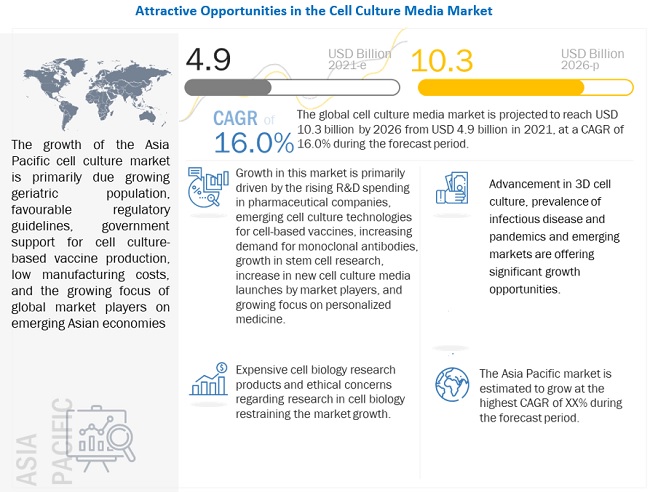According to the new market research report "Cell Culture Media Market by Type(Serum-free (CHO, BHK, Vero Cell), Stem Cell, Chemically Defined, Classical, Specialty), Application(Biopharmaceutical (mAbs, Vaccine), Diagnostics, Tissue Engineering), End User(Pharma, Biotech) - Global Forecast to 2026", published by MarketsandMarkets™, the market is projected to reach USD 10.3 billion by 2026 from USD 4.9 billion in 2021, at a CAGR of 16.0% between 2021 and 2026.
Browse in-depth TOC on "Cell Culture Media Market"
314 – Tables
41 – Figures
303 – Pages
Download PDF Brochure: https://www.marketsandmarkets.com/pdfdownloadNew.asp?id=97468536
The global cell culture media market is expected to grow at a CAGR of 16.0% during the forecast period. The growth of this market is majorly driven by the rising R&D spending in pharmaceutical companies, emerging cell culture technologies for cell-based vaccines, increasing demand for monoclonal antibodies, growth in stem cell research, the launch of new cell culture media by market players, and the growing focus on personalized medicine. On the other hand, expensive cell biology research products and ethical concerns regarding cell biology research are expected to hinder the growth of this market.
The serum-free media segment accounted for the largest share of the type segment in the cell culture media market in 2020.
Based on type, the market is segmented into serum-free media, classical media & salts, stem cell culture media, specialty media, chemically defined media, and other cell culture media. In 2020, the serum-free media segment accounted for the largest share of the market. This can be attributed to the advantages of serum-free media over other types of media, including consistent performance, increased growth & productivity, better control over physiological responsiveness, and reduced risk of contamination by serum-borne adventitious agents in cell culture.
The biopharmaceutical production segment accounted for the largest share of the application segment in the cell culture media market in 2020.
Based on application, the market is categorized into biopharmaceutical production, diagnostics, drug discovery & development, tissue engineering & regenerative medicine, and other applications. The biopharmaceutical production segment is further divided into monoclonal antibody production, vaccine production, and other therapeutic protein production. The tissue engineering & regenerative medicine segment is further divided into cell & gene therapy and other tissue engineering & regenerative medicine applications. The biopharmaceutical production segment is estimated to grow at the highest CAGR of 17.5% during the forecast period. The high growth of this segment is attributed to the commercial expansion of major pharmaceutical and biotechnology companies, the increasing demand for mAbs, and the growing regulatory approvals for the production of cell culture-based vaccines.
Request Sample Pages: https://www.marketsandmarkets.com/requestsampleNew.asp?id=97468536
The Asia Pacific region is the fastest-growing region of the cell culture media market in 2020.
Based on the region, the global market has been segmented into North America, Europe, the Asia Pacific, Latin America, and the Middle East and Africa. The Asia Pacific market is estimated to register the highest CAGR during the forecast period. The growing geriatric population, favorable regulatory guidelines, government support for cell culture-based vaccine production, low manufacturing costs, and the growing focus of global market players on emerging Asian economies are the major factors contributing to the growth of the cell culture media market in the Asia Pacific.
Key players in the cell culture media market include Thermo Fisher Scientific, Inc. (US), Merck KGaA (Germany), Danaher Corporation (US), and Sartorius AG (Germany), Corning Incorporated (US).
Speak to Analyst: https://www.marketsandmarkets.com/speaktoanalystNew.asp?id=97468536

No comments:
Post a Comment